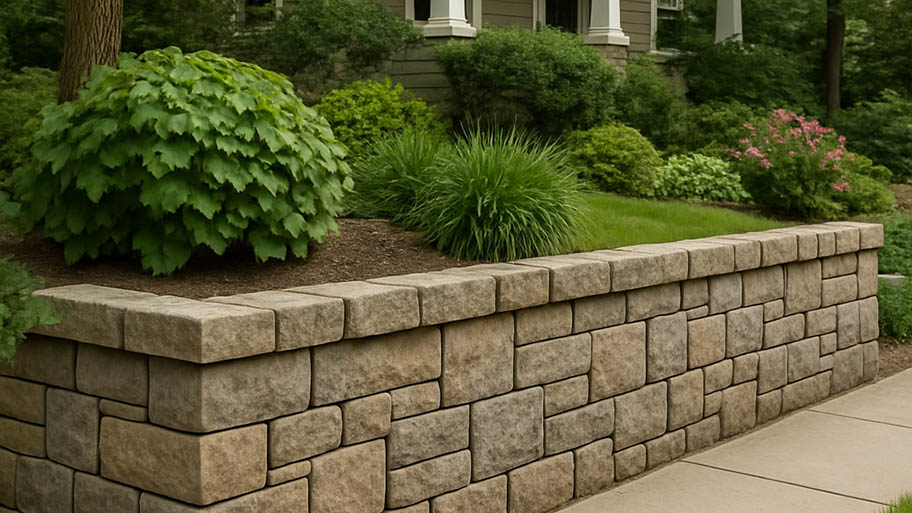
Kick erosion to the curb with an eye-catching retaining wall. Retaining wall costs vary based on the material, but this guide will help you budget.
Create a relaxing oasis right in your backyard


Hardscaping refers to the nonliving elements in an outdoor space.
Patios, walkways, driveways, and water features are all part of hardscaping design.
Hardscaping materials include stone, wood, gravel, and metal.
The best landscape design mixes hardscaping and softscaping.
Your property’s landscape design encompasses a lot more than just your lawn or garden. It also includes elements like your driveway, patio, or retaining walls—and there’s an art to making those things look great. That’s where hardscaping comes in. So, what is hardscaping? Learn more about what hardscaping is and how to incorporate it into your property to make your yard the envy of the neighborhood.
Hardscaping is the use of nonliving elements in your outdoor area, like a concrete walkway or patio. It can create a beautiful, multi-dimensional, multi-use outdoor space and even benefit your lawn.
If you’re a homeowner, odds are you’ve already used the idea of hardscaping without noticing. Your backyard gazebo? That’s hardscaping. The walkway through your garden? That’s hardscaping, too. Even your driveway or front gate is considered hardscaping.
Adding hardscaping features to your property has a variety of benefits, including the following:
Increases home value: Home buyers are drawn to properties with hardscaping features, allowing you to get more value out of your home when it’s time to sell.
Improves drought tolerance: Because hardscaping doesn’t require frequent watering like plants do, hardscaping features allow you to maintain an attractive yard even in times of drought.
Adds functional usable space: Hardscaping features allow you to extend your living space all the way outside, giving you additional places to entertain, cook, and enjoy the scenery.
Needs less maintenance than landscaping: While hardscaping features do require periodic maintenance, it’s much less of a time investment than watering, weeding, mowing, and trimming your plants and lawn.
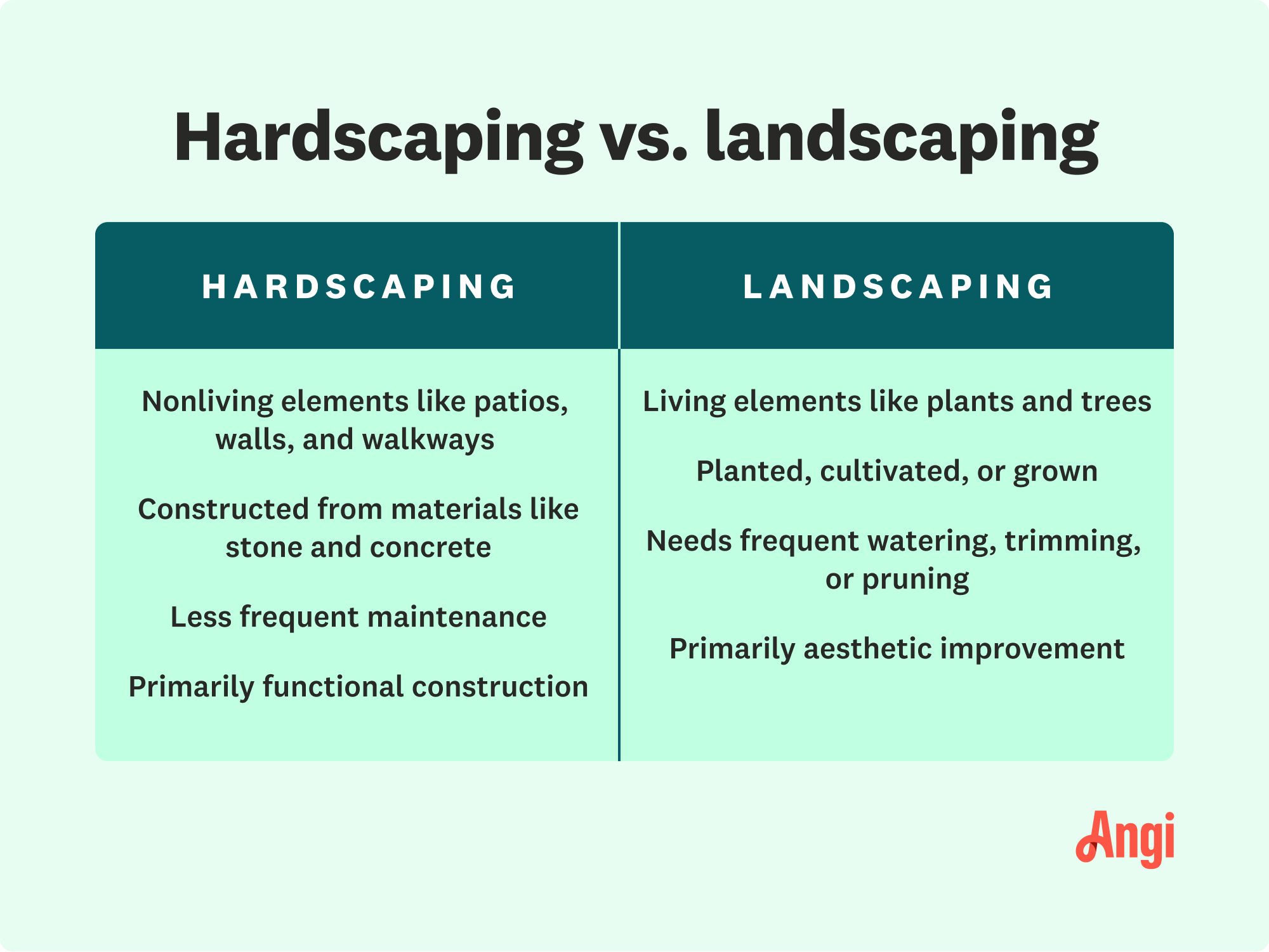
Landscaping (sometimes referred to as soft-scaping) is a catch-all term for designing and maintaining an outdoor space. Hardscaping is a subcategory that refers to the nonliving elements in an outdoor space, such as the paver patio in your backyard or the gravel path leading through your garden.
A hardscape includes nearly every element in your landscape that isn’t living. Even certain larger garden accents (think stones, fountains, and ponds) fall under the hardscape umbrella. There are many types of hardscaping features, and each uses different materials. Some projects are extensive and best left to professionals, while others are simple to DIY. Common hardscaping features are listed below.
Walkways provide convenient paths that lead from one part of your property to another. They are commonly constructed of paving stones, brick, or concrete.
While you may not think of your driveway as part of your hardscaping, it’s an important part of your property’s look and layout. Driveways can be made from a variety of materials, including stone, asphalt, and concrete.
Freestanding structures like pergolas and gazebos can add a luxurious feel to your yard. These structures can vary in size, features, and materials and are perfect for those who love to spend time outdoors but still be protected from the sun.
Decks add valuable space for your family to cook, eat, and relax. The cost of a deck can greatly vary depending on the size and material used. Decks are most often made from pressure-treated lumber or composite material, which is more durable than wood.
Constructed on the ground rather than attached to the house like a deck, patios make a great place to dine, sunbathe, or just hang out. Materials patios can be built from include concrete, decomposed granite, paving stones, and more.
Water features like fountains, ponds, waterfalls, and more add interest to a property and can be a calm oasis right in your yard. The cost to install an outdoor water fountain or other water feature can drastically change the look of your landscape for the better.
A retaining wall can serve both a functional and an aesthetic purpose. Often used to combat erosion or to make a sloped area more usable, paying for retaining wall costs can be an important structural feature that also adds to the look and feel of your yard.
A fence adds privacy to any property, keeping your yard out of view of passerbys and nosy neighbors. Fences can be a significant investment. The cost of a fence installation will vary according to the size of the fenced area and materials.
There’s nothing quite like sitting around a roaring fire on a chilly evening, and a hardscaped firepit can make that a reality right in your backyard. Firepits can be constructed in a wide range of sizes and out of a variety of materials.
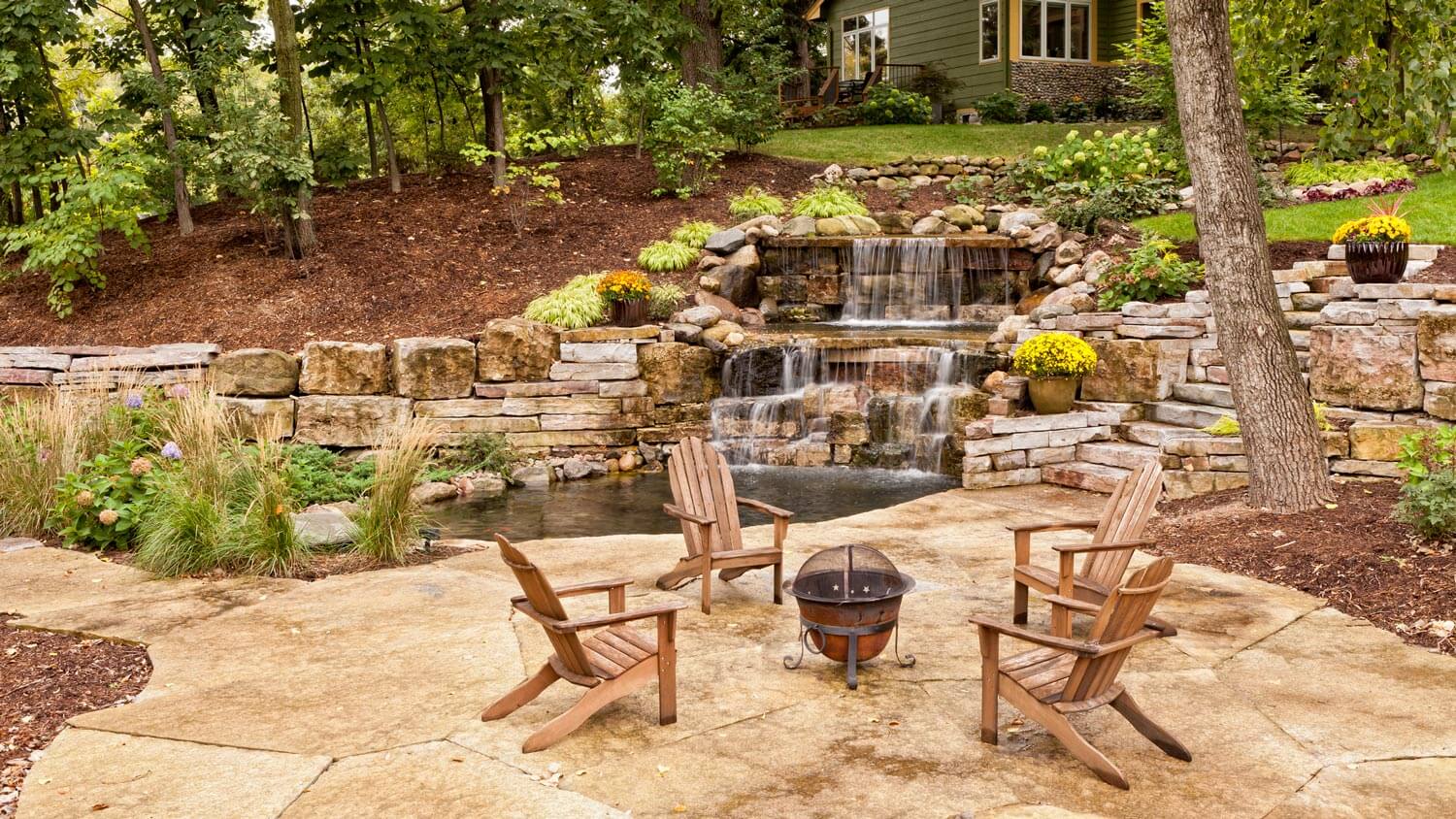
There's hardscaping material for every budget. High-end materials that require complicated processes (think laying down cobblestone or building a masonry wall) are a splurge. Other materials like concrete pavers, gravel, and asphalt are more budget-friendly. Popular materials include:
| Material | Best Uses |
|---|---|
| Coated steel or iron | Fences and gates |
| Asphalt | Budget-friendly option for driveways |
| Wood | Fences, decks, arbors, and other structures |
| Natural stones | Steps, patios, walkways, walls, and water features |
| Concrete | Pavers and slabs |
| Brick | Walls, walkways, and high-end patios |
| Gravel | Seating areas, driveways, and walkways |
| Ceramic | Fountains |
| Plastic or rubber | Water features |
The cost of hardscaping has a huge range, and a top-rated local hardscaper can help you determine a realistic budget. You may pay as little as $300 for a plug-and-play water feature or firepit. If you’re looking to do a larger project like building a porch or pond, costs could fall anywhere between $10,000 to $20,000. Spending as much as $100,000 on a high-end outdoor kitchen is not unheard of. Basically, the project will dictate the price.
Your landscape, environment, and desired aesthetic will inform the type of hardscaping material you need. For example, stone pavers are ideal for temperate climates. If you're not sure what material is right for you, consult with a landscaping professional.
Whether you’re looking for imaginative, inexpensive hardscaping ideas or want to completely redesign your outdoor space, there are a few things you should consider when planning a hardscape.
Work with what you’ve got. Hardscaping is both aesthetic and useful. You can use it to create a relaxing environment, but you can also use it to create walkways and outdoor entertainment areas. Your hardscape materials should complement your home. For example, don’t put in a pond that will potentially block a future walkway.
Create a focal point. Good landscape design builds around a main focal point. Pick a couple of focal points and use hardscape and softscape elements to complement them.
Look out for drainage issues. Hardscaping has a tendency to create drainage issues. Plan potential runoff so it doesn’t accidentally flood your foundation. Some hardscaping ideas like river rock can direct rainwater away from your home. Others, like asphalt driveways, can cause water to pool.
Mix softscaping and hardscaping. The best landscape design mixes softscape and hardscape elements. Make sure to work some greens into your hardscape, whether that includes planting flower beds around a gazebo or planting some ornamental trees along a walkway.
Keep it natural. If you’re using naturally occurring elements in your hardscape design, think about how they’d fit into nature. Sizing and placement are key. You don’t want your rock garden to look like it was just thrown from a pickup truck. It should blend into the environment.
Call a professional. Installing hardscaping can be extremely difficult and safety is a concern, especially when you’re installing decking or creating a water feature around existing electricity. If you’re planning a larger project, hire a hardscaper. You can also hire a contractor who specializes in your specific project, like a local mason or local driveway contractor.
From average costs to expert advice, get all the answers you need to get your job done.

Kick erosion to the curb with an eye-catching retaining wall. Retaining wall costs vary based on the material, but this guide will help you budget.
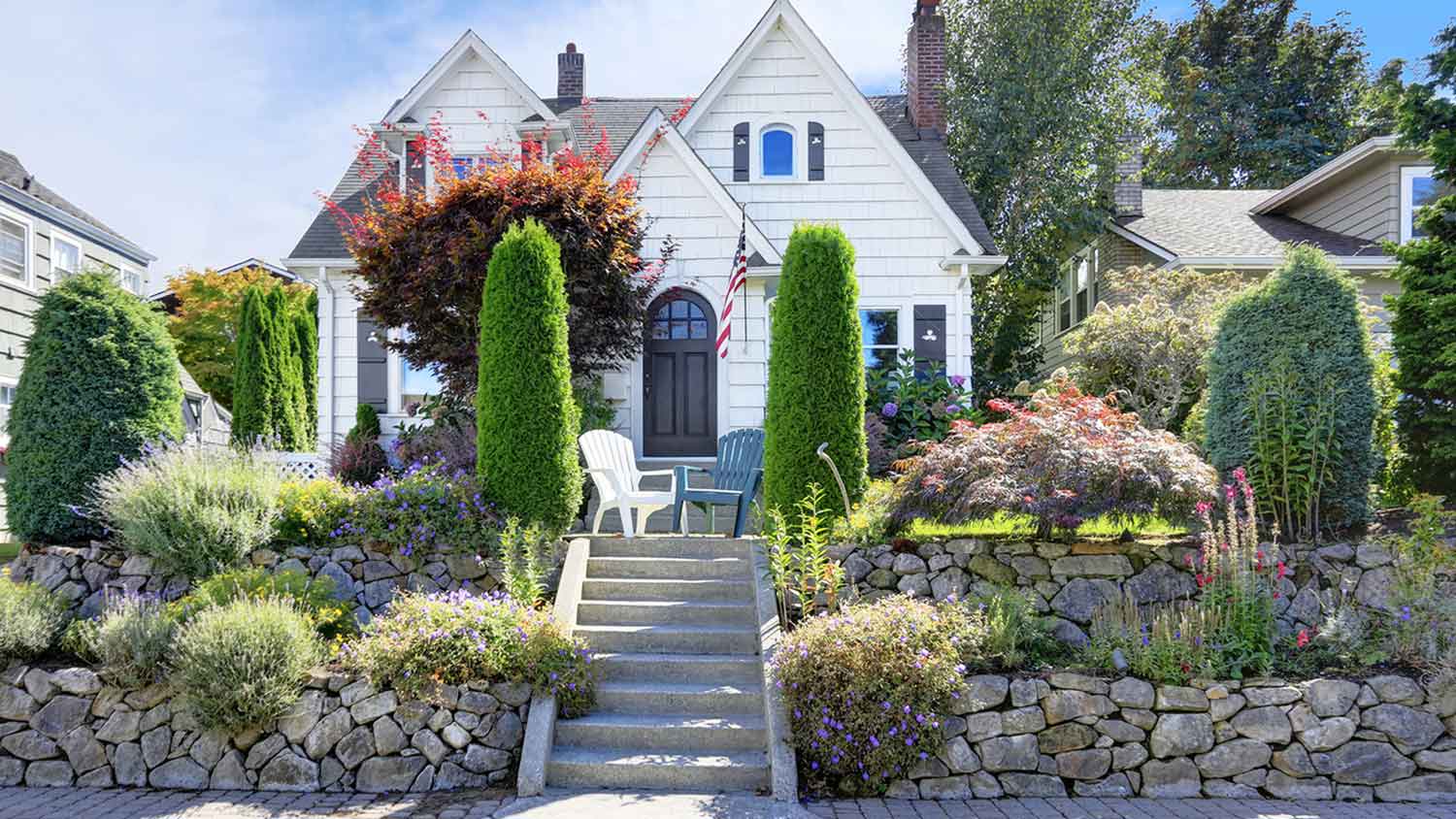
Retaining wall repair cost can vary widely based on the age and condition of the wall being restored. Learn why finding the right pro is important for getting the job done.

Pea gravel is a good-looking, versatile landscaping stone that's a favorite of the pros. Read about how much pea gravel costs for both installation and the stone itself.
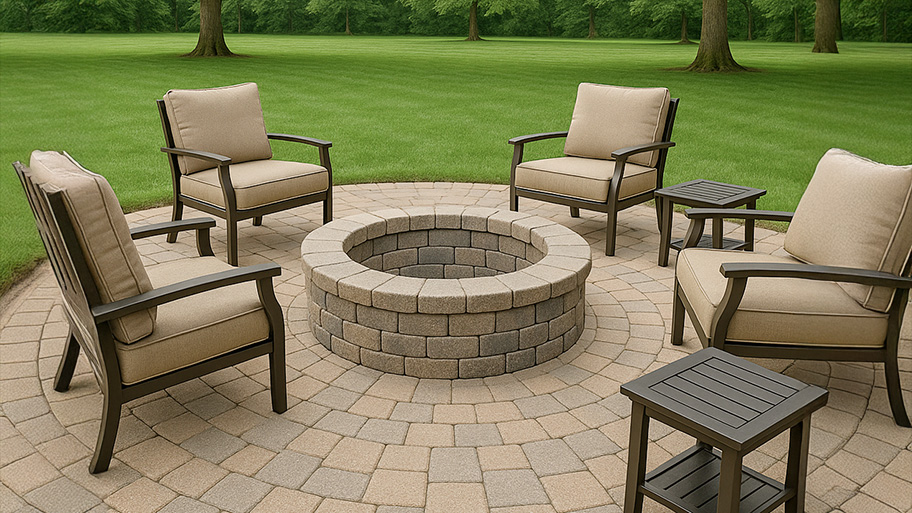
Interlocking pavers fit together easily, like puzzle pieces, using the power of friction to disperse weight, making them ideal for driveways and walkways.

If you’re looking to build a brick pathway or patio, there are lots of walkway patterns to choose from. Here’s a list of the most popular designs and types.

Use this calculator to determine how much paver base you need to successfully complete your paver project and enjoy your patio for years to come.